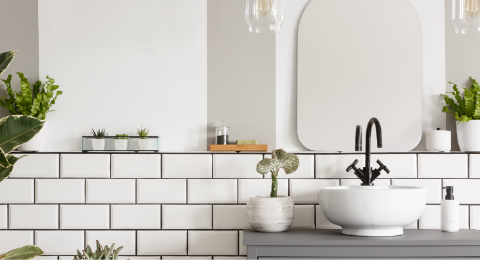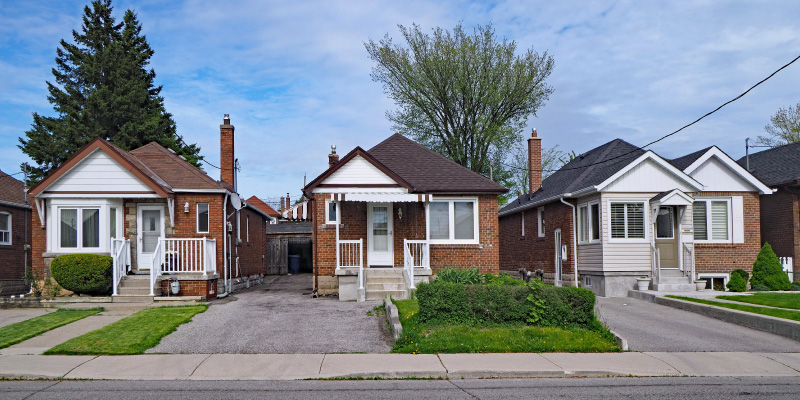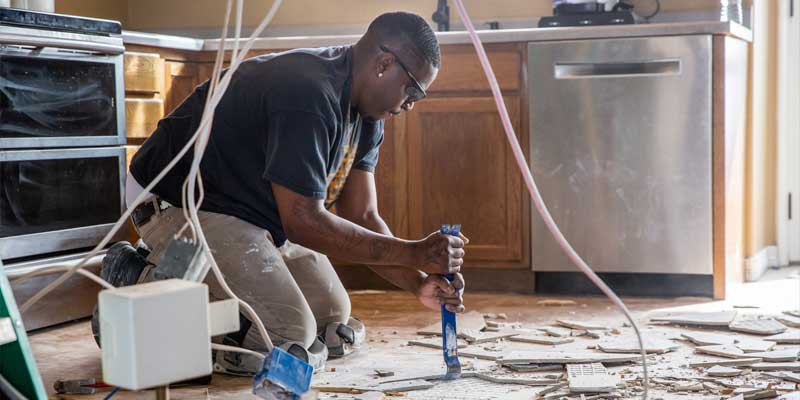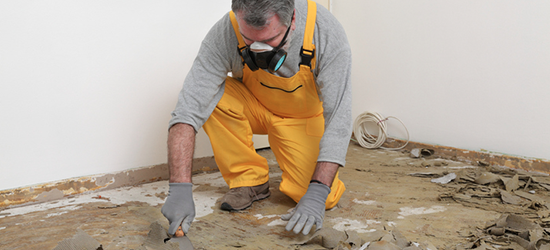
Updated November 19, 2023
When it comes to the world of DIY, there is endless information available to us. However, not every project can be completed with just a simple set of directions; some are more complex than that, and complications can easily arise.
We'll make it easier for you to determine whether or not your interior demolition project is DIY-able or better left to the pros.
There's no shame in admitting you need help with your project, so make sure you come to the best, most educated decision for you and your home.
The main factors you'll want to consider include your experience, physical ability, time constraints, and total cost.
We'll go over these popular DIY projects:
- Non-Load-Bearing Wall Demolition
- Load-Bearing Wall Demolition
- Kitchen Remodel
- Bathroom Remodel
- Floor Removal
Find interior demolition contractors in my area
Non-Load-Bearing Wall Demolition
Experience Level: 2/5
In additional to already having the appropriate tools on hand, you'll have to have to have experience and knowledge about how to dismantle the wall as well as what to look for in regards to safety. Tearing down the wall in sections is pretty straight forward, but what you can uncover behind the wall could require professional attention. Safety hazards like black mold, bug/vermin infestation, and electrical/plumbing are all situations that should be handled with care by a licensed professional.
Physical Ability: 3/5
You'll need to have the strength to tear out sections of the wall, as well as be able to lift these sections of drywall/lumber in order to dispose of them.
Time Requirement: 2-5 hours
Be sure to set aside an appropriate amount of time (wish cushion for set-backs and delays) to complete the project. If you have a particularly busy schedule, hiring someone to remove the wall for you could be a great option.
Average Cost: $0 - $100
Removing a non-load-bearing wall yourself isn’t too complicated, and the only costs are basic tools and disposal.
However, it is still important that you do your due diligence before going to work.
- Are you 100% certain this wall is non-load-bearing?
- What is behind (or inside) the wall you are about to demolish?
- Are there any electrical lines, pipes, gas lines, or hazardous materials, like asbestos, inside?
These are things you should know for sure before tearing down a wall.
If you can’t answer these questions, don’t leave anything to chance—get a hold of a professional.
Learn more:
- Wall Demolition Tips for the DIY Homeowner
- Interior Demolition Cost Breakdown for Appliance, Ceiling, Floor, and Wall Removal
- Before & After: Transforming Commercial Spaces Through Interior Demolition
Load-Bearing Wall Demolition
Difficulty Level: 4/5
Getting rid of a load-bearing wall is serious work and should not be underestimated. Not only will pipes and electrical wires need to be rerouted, but the weight of the house will have to be safely redistributed elsewhere.
When a load-bearing wall is removed, it must be replaced with one of the following...
- Horizontal beam - A “hidden” beam that stretches between two walls and has no vertical resting point
- Beam and post - In addition to the horizontal beam, there is also a vertical post that extends to the floor, helping to support the beam and the weight above it.
Unless you have experience doing this type of work, you shouldn't take the risk.
Physical Ability: 4/5
You'll not only need to have the strength to tear out sections of the wall and install a new load-bearing beam, but you'll need to have at least one other set of hands to help. This project assistant should also have experience with both construction and demolition, and understand the safety precautions that come with them.
Time Requirement: 1-3 days
Set aside a full 3 days to complete this type of project to account for any unexpected delays. If you're on a strict schedule, need this project completed ASAP, and aren't a licensed professional, it's worth bringing one into the equation.
Average Cost: $500-$1,000
Removing this type of wall will have costs regardless of if you do the work or you hire a contractor. You'll need to gather the appropriate permits, have a disposal plan, and also the material to replace the load-bearing function of a new beam.
Continue reading:
- Avoid Decision Fatigue When Remodeling or Upgrading Your Home
- 3 Remodeling Projects That Improve Your Home’s Accessibility and Boost Its Value
- Can't Move? Improve Your Home Instead
Kitchen Remodel

Difficulty Level: 4/5
Kitchen remodels can be big and complicated, or they can be simple and straightforward. The overall difficulty and cost of this type of project will depend greatly on the work you want done.
If you want to relocate a sink or appliances, or if you want to change the overall design of your kitchen, that’s a job best left to a professional. However, if you just want to redo your cabinets, replace your appliances, and paint, then that’s likely a job you could handle yourself.
Physical Ability: 4/5
Depending on what all your kitchen remodel entails, you'll have to have both the experience and strength to carry out the projects. Replacing cabinets, flooring, and appliances can be strenuous work, while painting is less physically demanding and can be handled by most DIYers.
Time Requirement: 1-14 days
The time required will depend on the extent of your remodel. Simple DIY remodels that just involve replacing cabinets can be completed in a day, while full overhauls can take weeks.
Repainting or tearing out walls, replacing cabinets and countertops, putting in new flooring, replacing plumbing, and installing new appliances and backsplashes are all examples of some of the most common projects involved in kitchen remodels. Be prepared for each project to last a day or two.
Average Cost: $10,000-$30,000
There are several factors that affect the total cost of your kitchen remodel, like where you live, the cost of materials, how long the project takes, how expensive disposal is in your area, and the type of working being done.
The good news is that kitchen remodels have a 60-70% return of investment on average, so the time and money you invest into the project now can yield great results in the future should you decide to sell.
Keep reading about kitchen remodeling:
- How to Find Kitchen Demolition Services Near You
- Pros and Cons of Doing Kitchen Demolition Yourself
- Stop Putting Off Your Kitchen Remodel—Get Started Today!
Bathroom Remodel
Difficulty Level: 5/5
Most bathroom remodels are complicated due to all the plumbing that is involved. Unless you're very comfortable with this type of work, hiring a professional is usually your best bet.
Physical Ability: 4/5
Just like with kitchen remodels, you'll have to have both the experience and strength to carry heavy materials and use brute strength when ripping our facets of your bathroom. Replacing vanities, flooring, and showers can be strenuous work, while painting is less physically demanding and can be handled by most DIYers.
Time Requirement: 2-14 days
The time required will depend on the extent of your bathroom remodel. Simple DIY remodels that just involve replacing flooring or painting walls can be completed in a day, while full overhauls can take weeks.
Tearing out walls, replacing vanities and/or tiling, putting in new flooring, replacing plumbing, or installing a new bathtub/shower are all examples of some of the most common projects involved in bathroom remodels. Be prepared for each project to last a day or two.
Average Cost: $8,000-$10,000
Don’t get blown away by the experience level and average cost listed above; this is the average cost for complete bathroom remodels.
Just like kitchen remodels, bathroom remodels can be as simple or in-depth as you’d like, as cheap or as expensive as your budget allows.
If you simply want to replace your floors and toilet and paint the walls, you can expect to do so for a fraction of this average. A simple remodel like that would be pretty straightforward to do yourself if you have the strength to carry a toilet and pry up flooring.
If you are planning a total bathroom remodel, on the other hand, it can be an extensive and complicated project. If you plan on changing your bathroom layout and relocating your sink(s), toilet, bathtub, or shower, then there will be quite a bit of plumbing work that needs to take place.
Similarly, if you plan to relocate outlets or lighting fixtures, you’ll need to have some electrical work done. Because so much can go wrong with plumbing and electrical work, we always suggest hiring a professional to do the work unless you have extensive experience yourself.
The good news is that kitchen remodels have a 60-80% return of investment on average, so the time and money you invest into the project now can yield great results in the future should you decide to sell.
Learn more about bathroom remodels:
- How to Find Bathroom Demolition Services Near You
- Avoid Draining Your Savings With These Bathroom Remodel Tips
- 5 Ideas for Small Bathroom Remodels
- 5 Beyond-Easy Ways to Save on Bathroom Demolition Costs
Flooring Removal
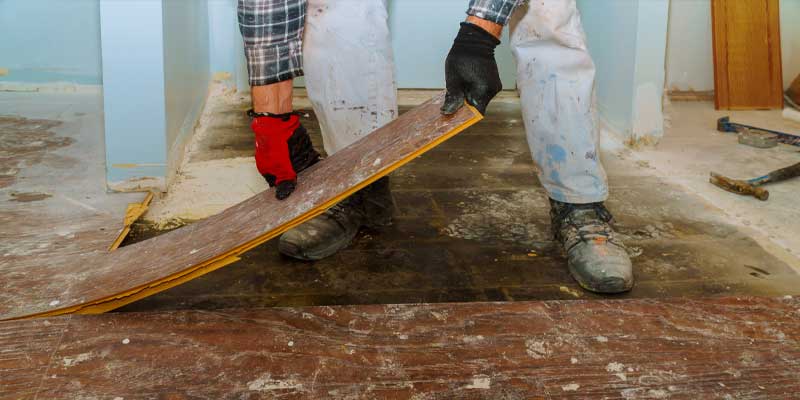
Difficulty Level: 1/5
While floor removal is essentially the same process regardless of the type of flooring, the exact approach to take will depend on the specific type of flooring and whether or not you want to salvage the materials.
Generally speaking, flooring removal involves:
- Carefully removing baseboards and/or trim work
- Removing any built-in furniture or appliances if possible
- Using the blunt side of a hammer to break up the first tile, panel, etc.
- Using the chisel side of a hammer or pry bar to pop up the flooring
This isn’t overly complicated work and doesn’t require many tools, but it can get tedious if the flooring was installed with glue or breaks apart easily. If you want to salvage the materials, you will have to take the time to be careful not to snap or break the tiles, panels, or floorboards.
Physical Ability: 2/5
Unless you have a history of neck, back, or knee pain, floor removal is a DIY-friendly project for most people.
We recommend hiring a professional if any of the following are true:
- It’s painful to be on your knees for extended periods of time.
- You have neck or back pain.
- You don’t have the time or patience to pry up an entire floor.
Time Requirement: 2-8 hours
Removing your flooring can usually be completed within a single day. Be sure to have a disposal plan in place prior to getting started so that you don't experience any delays.
Average Cost: $250-$450
The biggest costs involved with floor removal involve the cost of disposal. You can't just roll up carpeting and throw it in your curbside trash. The same is true for a whole room's worth of wood flooring or tile.
Renting a dumpster is the best way to dispose of old flooring. A 10 yard dumpster is typically sufficient and can be rented for around $250-$450 on average.
If you are impatient, get frustrated easily, or don't like the idea of doing manual labor during your free time, then DIY interior demolition isn’t for you, and that’s okay!
There are countless highly qualified interior demolition contractors near you who can help. Find the best one for you by searching on Hometown.
We make it easy to find contractors that service your zip code and request free estimates from multiples providers to compare pricing, customer service and availability.
Our sister site, Hometown Dumpster Rental, also makes it easy to find dumpster rentals and junk removal services when you need a disposal plan for your DIY project.
Get free interior demolition estimates
Continue reading:
